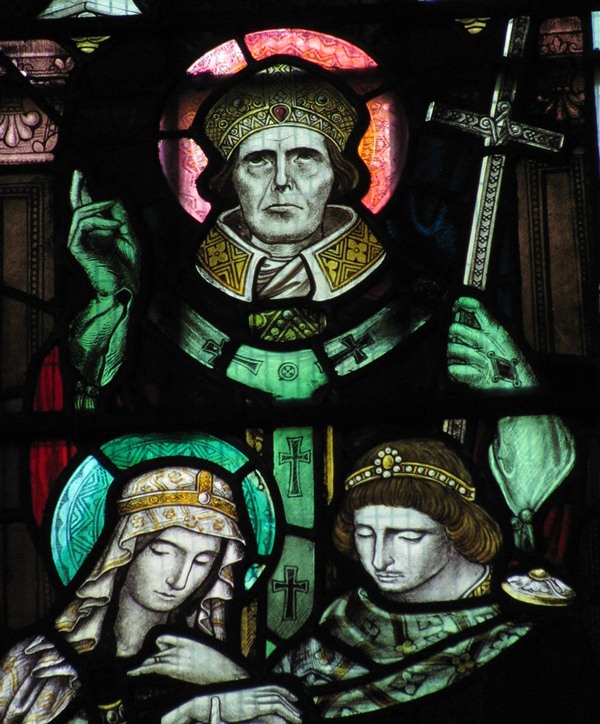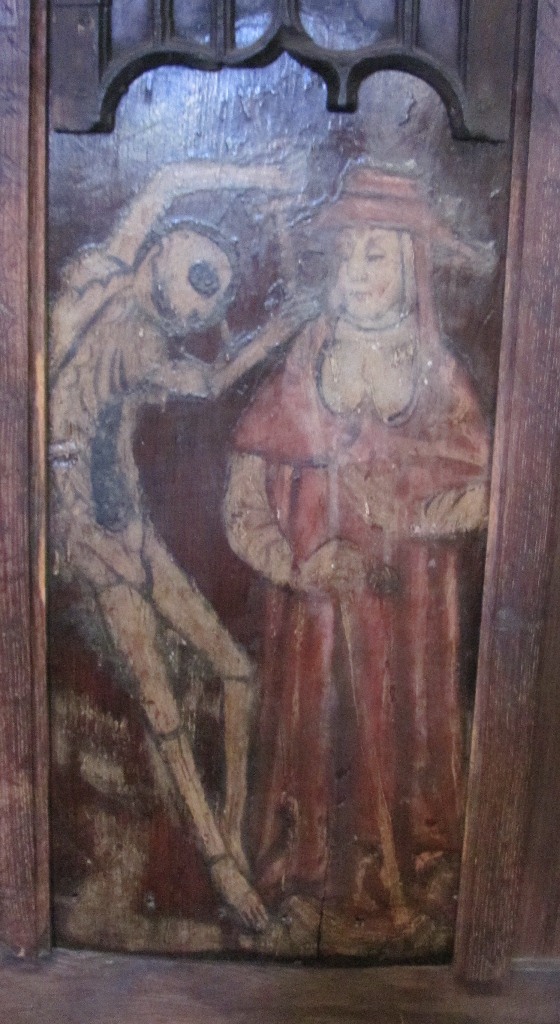By the time I had collected together all the pictures of things that I wanted to post from Hexham Abbey, I found that there was just to much to post in one go so here's the second post from our visit there. Actually there was too much to see in one go and we had to pop out for a cup of tea in the middle as well.
This window celebrating the Reverend Sidney Savage who was made by Davidson and Walker of Newcastle in 1909 (thank you the the lady from the abbey who e-mailed me this information - the abbey website now seems abundantly clear on the matter). In the first pane it features St Etheldreda and her marriage to Ecgthrith and the second pane shows her becoming a nun.
The third pane is described as a miraculous posthumous appearance. It's patently not by Etheldreda, who is the main feature of the rest of the window, so based on the story of the abbey, I would guess it is St. Wilfrid. Either way, I hope it cheered this glum fellow up.
This set of choir seats and pulpit has very little information on it. Perhaps I just missed it but it is in keeping with a lot of painted woodwork in the church, both in the screen which appeared in the last blog and a panel of paintings with scenes from the crucifixion, so I would say it's probably around 15 century.
A few of the panels feature people in the company of skeletons.
The next two pictures are from the aforementioned panels featuring the crucifixion. Much of the painting has been rubbed of in the intervening 600 years.
A window featuring St Peter in a little chapel dedicated to St. Wilfred.
Here's the man himself, very much in that style of Russian icon painting.
This little wooden enclosure is the Ogle Chantry built for "the Celebration of Holy Communion with Special Intention for the Soul of Sir Robert Ogle" who died in 1409.
This little triptych of paintings is thought to part of the original fittings of the chantry. It's not as skew wiff as it looks here - I couldn't get far enough away to take it all in a oner and had to put it together from three different photos.
A small anglo-saxon chalice.
From the tomb of Sir Gilbert de Umfreville
The seats you see above are misericords, which literally means "act of mercy". They had little shelves on the edge of the seat so that when they were folded up, a person could sit on them and appear to be still standing. The usually have carvings under the seat, sometimes Christian but, more often than not, obviously pagan or humorous and sometimes really quite rude. Nothing rude here but this one's certainly an odd creature.
A small dragon
Some of the arm rests have excellent carving. This one is a vulning pelican.
This sandstone seat is known as the Frith stool. Frith is a noun meaning peace,security and freedom from molestation and as a word has long since fallen out of use. During the middle ages it sat near to the altar and anybody that reached it was under the protection of the church (back in the 12th century anyone breaking the sanctity of the church was liable to a £96 fine - that more than for breaking the sanctity of a double yellow line these days but it would certainly be a chunky sum 900 years ago)
The seat itself dates right back into the early days of the abbey in the 7th century. During the 19th century, somebody managed to break it in two and now it's been cemented together again.
To get the best view of this window by Henry Holiday, we had to photograph it from half way up the ancient staircase.

























2 comments:
That's a cracking sequence of pictures Sandy.
It's amazing Hexham Abbey's survived after all the attacks on the town by us north of the border.
Here's a passage from Wikipedia.
"Like many towns in the Anglo-Scottish border area and adjacent regions, Hexham suffered from the border wars between the kingdoms of Scotland and England, including attacks from William Wallace who burnt the town in 1297. In 1312, Robert the Bruce, King of Scotland, demanded and received £2000 from the town and monastery in order for them to be spared a similar fate. In 1346 the monastery was sacked in a later invasion led by King David II of Scotland."
Great photos and it's good to know you and your camera were being suitably reverant given the location lol and humbly bowed your knees :) As of course you should in the presence of God. Love the little dragon!
Post a Comment